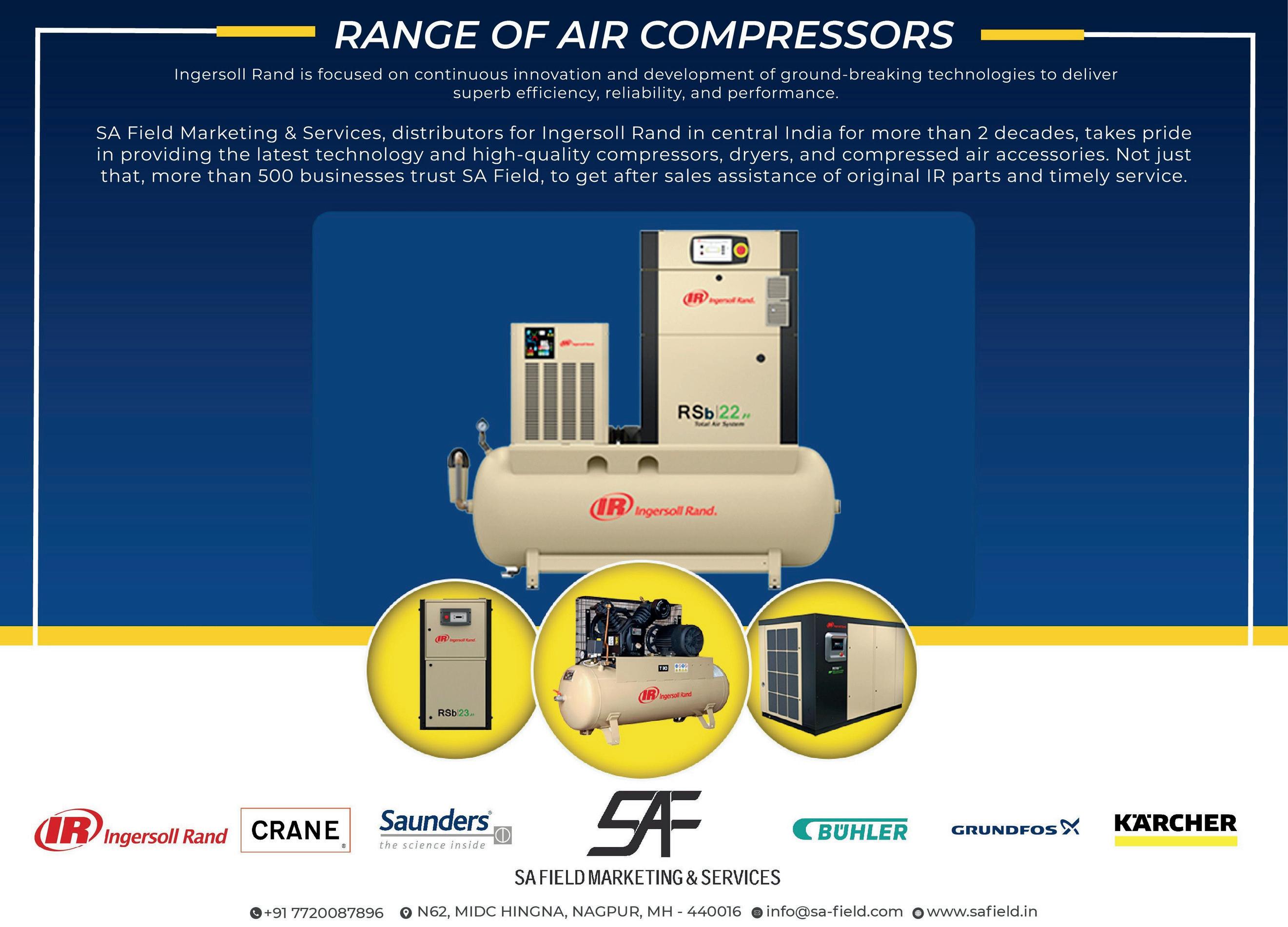

VISION
To promote Vidarbha as a preferred investment destination and create conducive environment for socioeconomic growth through industry and services
MISSION
To act as a catalyst between various stakeholders and authorities.
To create harmonious environment for accelerated industrial growth.
To provide a unified platform for policy advocacy at all levels.
To create, nurture and develop entrepreneurship and business leadership.
To enhance managerial and technical competency for excellence
CONTACT
Vidarbha Industries Association, 1st Floor, Udyog Bhawan, Civil Lines, Nagpur +91 712-2561211/2554090 www.viaindia.com | viangpindia@gmail.com
Download the VIA App

/vidarbhaindustrieassociation
/viasocialngp
EDITORIAL BOARD
Vishal Agrawal
Aditya Saraf
Ashish Doshi
Dr. Anita Rao
Shobha Dhanwatey
Mili Juneja
Sei Deshpande

PRESIDENT’S MESSAGE
According to data published by S&P Global, robust demand has driven India’s overall business growth in April to a nearly 14-year high. Business activity expanded, led by the manufacturing and services sectors. Increased new orders resulted in the highest output since 2010 and the service industry growth accelerated to a three-month high in new businesses as orders in domestic and international markets rose.
The demand conditions strengthened which meant that manufacturing margins improved as firms could pass higher prices to customers. Manufacturing industries sharply increased their staffing and input buying activity. Overall, the business outlook improved. However, despite the increased expansion, the data suggests that capacity expansion remained mild. In other words, pending orders, especially among private companies, increased.
As businesses strive to meet the increased demand and clear their backlogs, they will support job growth. This is especially true in the manufacturing sector where jobs have multiplied quickly in the last two years.
As we commemorate International Workers’ Day on 1st May, we must contextualise the findings of this report with the industrial growth of Vidarbha. Creating jobs for Vidarbha’s youth after supporting their education and skilling should be among our top priorities as industrialists and entrepreneurs. It’s clear from these findings that to meet this upturn in demand, we need to adequately honour the contributions of our human resources to retain their talents and contribute to the continued industrial growth of our region.
Warmregards,
Vishal Agrawal
President

SECRETARY’S MESSAGE
DearReaders,
In April, a VIA delegation met the Chief Minister of Maharashtra to submit a detailed memorandum on issues such as suggestions related to the development of industries, restoration of the original VidarbhaMarathwada energy incentive scheme, extension of electricity duty exemption which expired in March 2024, MIDC, MPCB, and IndustrialPolicy2024underpreparation.
30 VIA members visited the Kalmeshwar unit ofZimLaboratoriesLimited.Themanagement

Dear Readers,
EDITOR'S MESSAGE
To salute the indispensable contributions of the human workforce on International Workers’ Day, this edition’s cover story includes articles from three HR experts who shed light on some critical facets of people management. First, Dr. Suresh Pandilwar talks about recognising manpower as a company’s biggest asset, today and every day. Then, Col. Dr. Vasant Ballewar laments the untapped potential of people with disabilities and explains how empowering them entails fostering a culture of inclusivity and acceptance. Finally, Mr. Alok Dhotekar stresses the importance of proactive leadership in talent acquisition, emotional care, and retaining a skilled workforce for organisational success.
In their guest articles, Dr. Gajavelli V S highlights ESG compliance as an
welcomed the VIA team to their unit that couples a manufacturing facility with in-house R&D to produce a wide range of drug delivery solutions. Later, the VIA team visited VN SteelArch India Pvt. Ltd., Kalmeshwar, to appreciate their advanced integrated solutions inthepre-engineeredsteelstructuresector.
We also reached out to key government officials and departments with representations on matters such as the request for the deferment of the provision of section 43 B(h) of the IT Act1961, and the request offer for the enhanced quantity of Red Grade Coal and Linkage Auction Tranche-VII (Other Sub-Sector) from mines of WCL,Nagpur.
Ilookforwardtoyourcontinuedsupport.
Secretary - Ashish Doshiopportunity to differentiate in GVCs, CA Naresh Jakhotia elucidates the intricacies of the IT law while buying or selling property, Dr. Smita Singh (Dabholkar) explains the virtues of investing in the “emotional bank accounts” of the people in one’s business ecosystem, and Dr. Tejinder Singh Rawal talks about the dire consequences of a “ burgeoning wealth chasm” in the country. Our latest contributors Mr. Nihal S. Kothari and Ms. Rajeeta S. Sahasrabudhe share insights on various business liability insurance products that safeguard industries against all kinds of risks.
We endeavour to bring you the latest and most important news related to the industries of Vidarbha. We encourage all our readers to share write-ups to be published in subsequent editions of the ‘Enterprise’. Please write to us at viangpindia@gmail.com with your input and feedback.
- Aditya Saraf EditorRECOGNIZING MANPOWER AS AN ASSET: TODAY & EVERY DAY
 Dr. SURESH PANDILWAR Co-Chairman VIAHRDForum
Dr. SURESH PANDILWAR Co-Chairman VIAHRDForum
International Workers Day, also known as Labour Day in some countries and often referred to as May Day, is a celebration of labourers and the working classes that is promoted by the international labour movement and occurs every year on 1st May. In India, Labour Day is a public holiday held on every 1 May. The first celebration in India was organized in Madras by the Labour Kisan Party of Hindustan on 1 May 1923. This was also the first time the red flag was used in India. The party leader Singaravelu Chettiar made arrangements to celebrate May Day in two places in 1923. One meeting was held at the beach opposite the Madras High Court, and the other meeting was held at Triplicane. May 1 is also celebrated as Maharashtra Day and Gujrat Day to mark the statehood status of these two states in 1960. International Workers Day is an opportunity to honour and recognize the contribution of workers towards building infrastructure and providing essential services to society. It is also a reminder to acknowledge the struggle and movement of workers to attain their rights and improve working conditions. In today’s time, social inequality is still prevalent among workers across different industries and nations. May Day serves as a platform for these workers to raise their voices and tell the policymakers and to work in the direction of socialjustice.
When it comes to your company’s most valuable asset, a lot of areas come to mind. R&D, marketing, or even a patent might take the top spot. But that’s not even close to your company’s most valuable asset. The answer is the thousands of employees that make up the workforce of your company. Therefore, it’s your job to recognize manpower as an asset todayandeverydayandinvestinyour
manpowerbyprovidingthemwiththebestmicrolearningtraininganddevelopmentthatyoucan.In view of this and considering manpower as an asset, the government in 2019 and 2020 passed fourlabourcodes-CodeonWages2019,Codeon Social Security 2020, Industrial Relation Code 2020, and Occupational Safety, Health, and Working Conditions Code 2020 - to replace 29 labourlaws.Thegovernmenthadaimedthatthese codes would bring significant positive impact in India and that doing business in India would ease. The government sees them as ways to further increase the attractiveness of India as an investment destination. So far there has been no timeline from the government on the implementationofthesecodesandithasadopted a wait-and-watch policy as neither the employers northetradeunionsarekeenonthelabourcodes. Now we can speculate that the four labour codes are likely to be implemented after Lok Sabha ElectionsandAssemblyElections2024.
However, today, it’s considered to be the knowledgeofitsemployeesandtheirproductivity. All intangible assets such as patents, copyrights, intellectualproperty,brands,trademarks,andR&D are created by people. Therefore, people matter most to you and your business. They are the most essential contributors toward profits and shareholdervalue.Thatsaid,peoplearekeyassets for any organization. In today’s continuously changing business world, it’s human assets, not fixed or tangible assets, that differentiate an organization from its competitors. The knowledge economy distinguishes one organization from another.
Manpower champions your business and determinesitssuccessorfailure.Theworktheydo determines what customers and partners see, so you need to treat your manpower with the value they bring. Manpower leading an organization might be able to be replaced physically, but their skill sets and knowledge can’t be. This is because each person hired brings a different set of skills to the table even though the job yields the same set ofskills.
Besides, the skill set of manpower accounts for 65% of a company’s assets. Therefore, manpower efficiency and talent determine the pace and growth of an organization. Organizationsneedtorecognizethevaluetheir manpower has and praise them accordingly. This includes their knowledge, expertise, abilities, skill sets, and experience. These are all invaluable and intangible assets for securing a future for the company. So, when manpower feels valued, they will gladly compete in the race and beat the competition. But one thing must be remembered is that manpower is not an asset of the company; only good manpower isanassetofthecompany.
This time VIA is releasing this special issue on “recognizing manpower as an asset - today and every day”, hence, we must understand that no matter what size the business is, success is the result of continuous hard and smart efforts put in by happy and valued manpower. This results in keeping the organization going, competing with its competitors,andgettingaheadofthemall.
It’s the satisfaction level of your employees that matters the most. So, if employees aren’t happy, they might spread negative words about the organization, even after leaving it. What’s more, an unhappy employee will lack motivation and will not perform well, leading to unsatisfactory performance. This results in unachievable performance targets, low profits, and employee churn.
Think of your employees as the best marketing for your business. Remember that they are the face of your company. They will talk to family and friends, and even new people they meet, about your company. When someone asks what they do for a living, you want them to have positive things to say about your company. Happy, satisfied employees will highlight the integrity of your business for example the Tata organization. Once you recognize that your employees are your company’s asset, you make sure you serve them well and engage in organizational activities which would help you in achieving your objectives. Happy International LabourDay2024.
PEOPLE MATTER: CELEBRATING INT’L WORKERS’ DAY
UNLOCKING POTENTIAL: HARNESSING THE TALENTS OF PWDS

COL. DR. VASANT BALLEWAR
M.A. (Psy.), Ph.D Dean, Queen Mary's Technical Institute For Rehabilitation of Disabled Soldiers, Pune
People with disabilities (PWDs) often possess extraordinary compensatory talents bestowed by nature, offering remarkable abilities that defy conventional expectations. For instance, blind individuals often develop superhuman hearing capabilities, honing their auditory senses to navigate the world with astonishing precision. Amputees frequently demonstrate enhanced strength or dexterity in their remaining limbs, adapting to their physical challenges with remarkable resilience and power. Moreover, individuals with mental disabilities often exhibit extraordinary levels of intelligence or creativity, harnessing their unique perspectives to excel in various domains.Theseinnatetalentsnotonly
showcase the remarkable resilience of disabled individuals but also highlight the richness and diversity of human capabilities beyond traditionalnorms.
An estimated 1.3 billion people experience significant disability, this represents 16% of the world population (WHO report, Mar 2023). The overall prevalence of PWDs in India is 4.52% of the population i.e. 63.28 million (ICMR’s publication, NFHS-5 survey 2019-21). Despite comprising a significant portion of the population, PWDs often face societal barriers that hinder their full integration and utilization of their talents and potential. Whether their disabilities are congenital or acquired later in life due to various circumstances such as diseases, accidents, military service, or sports injuries, many of these individuals find themselves marginalized, deprived of opportunities, and sociallyrejected..Consequently,theirvaluable
skills and capabilities remain underutilized, leading to a waste of potential. By providing tailored vocational training programs with due consideration to their disability and mental aptitude, these individuals can acquire the skills needed to pursue meaningful careers, live independently, thereby fostering a sense of self-reliance and dignity, and contribute to society.
The untapped potential and human resources of disabled individuals represent a tragic loss for society, stemming from deeply entrenched taboos and negative perceptions perpetuated by ostensibly able-bodied individuals. Despite possessing remarkable abilities and talents, many disabled individuals find themselves sidelined, their contributions overlooked due to prevailing biases and misconceptions. This wastage of manpower not only deprives these individuals of opportunities for personal fulfilment and economic independence but also deprives society of the diverse perspectives and talents they bring. We must challenge these societal barriers and foster an environment of inclusivity and empowerment, recognizing and harnessing the immense potential that exists within every individual, regardlessofability.
EmpoweringPWDs
In today's diverse and inclusive society, the employability of PWDs should become a focal point in corporate and government sectors, as well as within entrepreneurship. Efforts are required to create opportunities, recognise the invaluablecontributionsanduntappedpotential of this demographic section, and foster environments conducive to their integration andsuccess.
Government sectors worldwide are taking steps to promote the employability of PWDs. Legislation and policies aimed at eliminating discrimination and promoting accessibility are being enacted, encouraging public sector organizations to lead by example. Moreover, government agencies are partnering with private enterprises and non-profit organizations to develop training programs and support services tailored to the needs of PWDs,enhancingtheirskillsandemployability.
In the corporate sphere, a paradigm shift is occurring as companies increasingly prioritize diversity and inclusion initiatives. Many organizations are implementing inclusive hiring practices and accommodations to ensure that PWDs have equal access to employment opportunities. From tailored recruitment processes to workplace adjustments like assistive technologies and flexible work arrangements, companies are striving to create environments whereallemployeescanthrive.
Entrepreneurship presents another avenue for PWDs to pursue meaningful and fulfilling careers. By starting their businesses, they can leverage their unique perspectives and talents to create innovative solutions and products. Moreover, entrepreneurship offers flexibility and autonomy, allowing individuals to customize their work environment and schedule to accommodate their specificneeds.
However, despite progress, significant challenges persist in promoting the employability of PWDs. Barriers such as stigma, lack of accessibility, and limited access to education and training opportunities continue to hinder their full participation in the workforce. Addressing these challenges requires a multifaceted approach involving collaboration between governments, businesses, educational institutions, and advocacy groups.
Educationandskilldevelopmentplayacrucialrole in enhancing the employability of PWDs. By providing inclusive education and training programs tailored to their needs, we can equip them with the knowledge and skills necessary to succeedindiversefields.
PossibleSectorsofEmploymentforPWDs
With appropriate vocational training, PWDs can be used for the undermentioned tasks in the corporate,publicandentrepreneurshipsectors.
1.
Visual Impairment: Software Developer, Customer Service Representative (with appropriate accommodations), Policy Analyst, Administrative Assistant, Accessibility Consultant,FreelanceWriteretc.
3.
Hearing Impairment: GraphicDesigner,Project Manager, Social Media Manager, Researcher, Sign Language Interpreter Service, Video ContentCreatoretc.
2. Mobility Impairment: Data Analyst, Accountant,HumanResourcesManager,Urban
Planner, Online Store Owner, Virtual Assistant ServiceProvider.
4. Neurodiversity (e.g. Autism Spectrum Disorder): Software Tester, Data Entry Specialist, Research Assistant, Statistician, App Developer, Specialized Tutoring Service etc.
5. Intellectual Disability: Inventory Clerk, Janitorial Staff, Mailroom Assistant, Groundskeeper, Recycling Business, Pet Care Serviceetc.
6. Psychological Disabilities (e.g. Anxiety, Depression): Copywriter, Social Media Manager (with remote work options), Crisis Hotline Operator, Online Content Moderator, Mental Health Coaching, Online Therapy Platformetc.
These are just examples. Actual opportunities may vary based on individual skills, interests, and accommodations needed. Employers and society in general need to create inclusive environments where PWDs can thrive in various sectors. The possible remedies, measures and modalities to promote the employmentofPWDsare:
Accessibility and accommodations: Ensure workplaces are physically accessible with ramps, elevators, and accessible restrooms. Provide assistive technology, such as screen readers, magnifiers, or hearing aids, as needed. Offerflexibleworkarrangements,including remote work options, flexible hours, and part-timeschedules.
Training and education: Provide disability awareness training for all employees to foster an inclusive workplace culture. Offer job training programs and apprenticeships specifically designed for PWDs. Partner with vocational rehabilitation agencies like QMTI, Pune, to support skill development andjobplacement.
Reasonable accommodations: Implement reasonable accommodations to ensure equal opportunities for PWDs. Conduct individualised assessments to determine the specific accommodations needed for each employee. Maintain open communication channels to address any accommodationrequestspromptlyand
effectively.
Anti-discrimination policies: Enforce strict anti-discrimination policies and ensure compliance with disability rights laws. Promote equal opportunities for career advancement and professional development for employees with disabilities. Establish grievance procedures to address discrimination or harassment concerns promptly and effectively.
Mentorship and support networks: Facilitate mentorship programs pairing employees with disabilities with mentors who can provide guidance and support. Establish employee resource groups or affinity networks for PWDs to foster community and belonging. Create access to disability-specific support services, such as counselling or peer support groups.
Promotion of inclusive hiring practices: Proactively recruit candidates with disabilities through partnerships with disability advocacy organisations and job fairs. Train hiring managers and recruiters on inclusive hiring practices and unconscious bias awareness. Consider implementing diversity hiring goals or quotas to ensure the representation of PWDs in the workforce.
Conclusion
The employability of PWDs is a critical issue that requires concerted efforts from all stakeholders. The recent surge in attention and affirmative action towards PWDs marks a promising shift in societal attitudes and governmental policies. However, despite these advancements, the stigma and discrimination surrounding disability persist. It’s imperative for ongoing efforts to focus not only on practical accommodations but also on fostering a culture of inclusivity and acceptance, ensuring that PWDs are included and fully embraced as valued members of the community. There is still much work to be done to dismantle barriers and promote genuine equality for all.

VIA DELEGATION MEETS CM TO APPRISE INDUSTRY ISSUES

restoration of the original VidarbhaMarathwada energy incentive scheme, extension of electricity duty exemption which expired in March 2024, MIDC, MPCB, and Industrial Policy 2024 under preparation. Highlights:
There is a need for sectoral policies so that every unit can avail of the PSI benefits.
Industries, especially MSMEs, in sectors such as steel, plastic, food and farming are power intensive and are on the verge of closure due to exorbitant power charges. Power must be provided at an affordable rate since the closure of these industries will impact industrial production, causing loss of employment and livelihood.
The anomaly in the definition of MSME for subsidy under PSI should be removed wherein investment in plant and machinery up to Rs. 50 crores and turnover of Rs. 250 crores is considered as MSME. This definition has not been adopted by DIC for the scheme and they are continuing with the old definition and FSI up to Rs. 50 crores.
Special LSI and LSI units get fewer benefits compared to MSMEs and mega units which discourage MSMEs from graduating to LSI.
The surplus claim is carried forward only for one year and the deficit is not carried forward. Units shall be allowed to avail the overall amount sanctioned within the tenure.
Expansion and diversification of units should be treated at par with new units during the dispensation of incentives under PSI to encourage sustainability of the unit planning expansion and reward continuity of growth of employment and economy in the region.
Incentives for installing solar power for captive use should be encouraged.
Consider the investment under captive power as an eligible investment and de-link the interest subsidy with the power bill.
Reintroduce/extend the industrial policy for women entrepreneurs wherein the subsidy was equal to 100% of fixed capital investment for five more years.
Consider the full sale value as an eligible investment in case of resale of MIDC land. Issue guidelines for units acquired through NCLT as presently no guidelines are present in the PSI.
On the occasion, Rashmi Kulkarni, Chairperson of VIA LEW submitted a proposal for a women-owned industrial park in Nagpur to provide dedicated infrastructure and business opportunities to women entrepreneurs.
Shinde assured the members that the government is concentrating on formulating special sectoral policies to enhance the growth and progress of Vidarbha. He further assured that he would incorporate the suggestions shared by the industrial fraternity and take up the issues with the concerned departments for prompt resolutions.
The VIA delegation was led by Pravin TapadiaPast President of VIA and notably included Suresh Rathi - IPP of VIA, Rohit Bajaj - former Vice President of VIA, Shelendra Manawat, Girish Deodhar, Rashmi Kulkarni, Dr Anita Rao, and Reeta Lanjewar.
HUMAN CAPITAL: THE VITAL ASSET OF AN ENTERPRISE
 ALOK DHOTEKAR
ALOK DHOTEKAR
Knowledge Resource - The Right Angle
Soon after getting into business/enterprise or even normal work life, we realise the fallacy of not having paid due attention to economics in our academic studies. The regret goes on for some time and eventually, we find ways to learn and catch up. Some do it on their own and some resort to auxiliary help. However, in that cycle, we surely recall the basic tenet of economics that the factors of production are land, labour, capital and enterprise. From that, we realise that if the enterprise is initiated rightly then arranging capital, and through it, land, is just a manoeuvre. However, the essential factor, labour, is not an easy cakewalk.
We progressed from “Labour Welfare Officer” to “Personnel Manager” and eventually to the present: “HR Manager”. The Education Ministry of the Union Government changed to the Human Resources Development Ministry in 1984. The term “labour” needs to be referred to as “workforce” and eventually, they have become a vital element of the present-day, for growth and survival. We can soon expect to see a numerical and technical definition for the measurement of human capitalincludedinbusinessfigures.
We are aware that good human capital is in the “critical to qualify” (in some cases even “essential to qualify”) factor for many initiatives. Many enterprises wouldn’t have seenthelightofdayifaskilledworkforcewas not available. Equipment operation, organising operations back end, project management and even business intelligence and analytics, all call for specialised, focussed and clarity-filled human elements. The organisation that can recruit, nurture and hold ontoitshumancapitaloveralongerbusiness
cycle, is bound to shine and graduate from an enterprisetoaninstitution.
Not following SOPs in spirit can be a deterrent. Even at the drafting stage of the SOP, emotional care of the workforce thought dimension need priority. Needs vary at the shop floor, field force, the back-office team, or the top management but every level is vital. The key is getting every element, top to bottom, to arrive at work with body,mindandsoul.
Having the right team emerges out of the right inwards of talent and willingness. Leaders have to enhance their own/teams’ interviewing skills togetcandidateswithbalancedKHASattributes (Knowledge, Habits, Attitude and Skills). Working out the weightage of these elements will make matters easy during selection. Some don’t care for attrition of their organisation but let’s not become a training institute and conserve resources for other good of the organisation.
Attracting, extracting work and retaining the first-level skilled/unskilled workforce has become an open challenge for all. No golden rules apply to address this harsh reality. Monetary lures are seen as the best resultyielding act. Commercials will have to be tuned up in other dimensions for cost balance. But once peers also apply the same principles, the huntfornewwayswillhavetostart.
Creating emotional bonds is essential to insulate the workforce from the massivelooking-yet-small-differential-monetary-rise traps by other firms. Employees accept an offer if they feel assured of continuity, security, respect and satisfaction. If we can ensure that these factors are paid attention, the relationships will be long-lasting and the human capital will be a contributing factor for the organisation.
Happy human capital nurturing and prospering to all on the occasion of World Labour Day.

TACKLING RISING INCOME INEQUALITY
DR. TEJINDER SINGH RAWAL CharteredAccountantIn a recent report published by the World Inequality Lab, concerning revelations have emerged regarding India's economic landscape. Titled ‘Income and Wealth Inequality in India, 1922-2023: The Rise of the Billionaire Raj’, the findings underscore the alarming escalation of income and wealth disparity within the nation.
According to the report, India finds itself grappling with unprecedented levels of inequality. In the fiscal year 2022-23 alone, a staggering 22.6% of the national income was cornered by the top 1%, marking the highest proportion observed in a century. Concurrently, wealth inequality has reached alarming heights, with the top 1% controlling a substantial 40.1% share of the nation's wealth—a figure not seen since 1961.
The consequences of this burgeoning wealth chasm are dire. The share of wealth held by the top 10% has surged from 45% in 1961 to a staggering 65% in 2022-23. Conversely, the bottom 50% and the middle 40% find themselves increasingly marginalised, with their share of wealth dwindling.
Economists and policymakers have voiced concerns over the detrimental impact of this growing inequality. Recent studies by the International Monetary Fund (IMF) highlight an alarming inverse relationship between the income share of the affluent and GDP growth.
For every 1 percentage point increase in the share of the top 20% of the population, GDP growth is observed to decline by 0.08 percentage points over the subsequent five years, indicative of a flawed trickle-down economic model.
The WIL report suggests a multifaceted approach to mitigate the tide of inequality and foster inclusive growth. Promoting growth strategies that generate non-farm employment and foster structural change is deemed imperative. Additionally, ensuring social protection for the informal workforce, implementing progressive taxation, revitalising public expenditure, and addressing identitybased inequality are crucial steps in narrowing thewealthchasm.
As India stands at a critical juncture, the imperative to combat rising income inequality has never been more pressing. Embracing progressive policies and prioritising social equity are paramount in paving the path towards a morejustandinclusivefutureforallcitizens.
It’s critical to carry out sweeping reforms in the education and healthcare sectors to guarantee equitable access to opportunities and services. By directing resources towards enhancing the quality and accessibility of education and healthcare, profound changes can be effected in the lives of individuals hailing from marginalised communities.
Investments in education are particularly pivotal as they catalyse empowerment and socioeconomic mobility. By improving the quality of education and expanding its reach to underserved areas, barriers to learning can be dismantled, allowing individuals from all backgroundstounlocktheirfullpotential.
Moreover, initiatives to provide scholarships, vocational training, and skill development programs can equip marginalised youth with the tools they need to succeed in a rapidly evolving jobmarket.
Similarly, investments in healthcare are indispensable for breaking the cycle of intergenerational poverty. Access to quality healthcare services improves health outcomes and enhances productivity and economic resilience. By establishing robust healthcare infrastructure, includingclinics,hospitals,and
community health centres, individuals from marginalised backgrounds can receive timely medical care and preventive services, mitigating the impact of healthrelated setbacks on their livelihoods. Addressing systemic issues such as inequitable distribution of healthcare resources, inadequate healthcare financing, and gaps in healthcare coverage is essential for ensuring universal access to healthcare services.
Nurturing entrepreneurship and innovation within marginalised communities holds immense promise for catalysing economic upliftment and diminishing reliance on conventional employment sources. By empowering individuals of disadvantaged backgrounds to embark on entrepreneurial ventures, new pathways to prosperity can be forged, driving sustainable economic growth and social inclusion.
Facilitating access to capital is a pivotal in unlocking the entrepreneurial potential of the aspirants. With micro-finance initiatives, low-interest loans, and grants, budding entrepreneurs can overcome entry barriers and kick-start their businesses. By pairing novice entrepreneurs with seasoned mentors who offer guidance, advice, and practical insights, invaluable knowledge and skills can be transferred, accelerating the growth and success of fledgling enterprises. Mentorship programs can help cultivate a supportive ecosystem where aspiring entrepreneurs feel empowered to pursue their dreams and overcome challenges with confidence.
Establishing market linkages is essential for connecting entrepreneurs from marginalised communities with potential customers, suppliers, and partners. By facilitating access to markets, trade fairs, and networking events, aspiring entrepreneurs can showcase their products and services, expand their customer base, and forge strategic partnerships. Forging collaborations with established businesses and government agencies can open doors to new opportunities and resources, enabling entrepreneurs to scale their ventures and achieve long-term success.
Enhancing transparency and accountability in governance is crucial for combating corruption and ensuring equitable distribution of resources. Strengthening institutions, promoting participatory decision-making processes, and enforcing stringent anticorruption measures can restore public trust and promote inclusive growth.
Promoting social cohesion and fostering dialogue among diverse groups is essential for building a more inclusive society. Emphasising shared values of tolerance, diversity, and mutual respect can bridge divides and create a conducive environment for collective action towards addressing inequality.
Addressing rising income inequality in India requires a holistic approach that encompasses economic, social, and political dimensions. By implementing comprehensive reforms and fostering inclusive growth, India can realise its potential as a prosperous and equitable society where every individual has the opportunity to thrive.

MANAGEMENT MATTERS: EMOTIONAL BANK ACCOUNT

DR. SMITA SINGH (DABHOLKAR)
Associate Professor IMTNagpurLet us look at a career in sales as far as this article is concerned. We may put all the knowledge across in a sales conversation, possess good product knowledge, use the best PowerPoint templates and display extraordinary languageskills,yetwemaynotendupmakinga persuasivepitch.Whatelsemayberequired?
StephenCovey,theauthorof“7HabitsofHighly Effective People”, presents an interesting and convincing strategy for building trust and explains how it’s critical to both personal and professionalsuccess.Hecomparesbuildingtrust to making deposits in an “emotional bank account”. Covey uses this metaphor to explain thatbuildingtrustislikemakingregulardeposits inanotherperson’semotionalbankaccount.This demonstrates consistent evidence that you are trustworthy. As one makes deposits in the form of listening, being well prepared for meetings, keeping one’s promises and delivering on them, the ‘balance’ in the trust account grows. When one fails to honour commitments, makes the other person feel unappreciated or unimportant or behaves unacceptably or inconsistently, one makes‘withdrawals’.Hefurtherexplainsthatlike with any other bank account, when one makes many withdrawals and allows their account balancetobecomeoverdrawn,theyhavetoface penalties. One loses trust, and this eventually affects the relationship adversely. Covey is famous for such metaphors and therefore a management guru par excellence. His managementtheoryis-“seekfirsttounderstand andthentobeunderstood”.De-prioritizingone’s needsandbecomingmoreopentosolutionsare someofitsgoldenofferings.
In a recent sales coaching conversation that I was involved in, I came across a coachee who had been delivering top performance consistentlyformorethanadecade.
His product know-how and proactive solutionfocused approach stood out but moreover, his habits like keeping time, keen listening, summarizing a sales call, and doing his homework beforehandstoodoutclearly.WhenItalkedtoone of his newly joined team members who was way younger than him in age and experience, it became more clear how he was consistently achievinghistargets.
This junior team member shared that he had worked with several bosses in the past but working with this boss was a novel experience. Whenever they went for a sales call together, this newbossmadeanefforttointroducehimfirstand made sure that he was an active member of the conversation. He even asked for his suggestions in front of the client and appreciated him in their presence. He never missed calls from the client and in case he did, he always called back. Even when he was aware he would face a backlash in certainsituationsbecauseofdelaysindeliveryetc, heneveravoidedanycalls.Hemadesurehemade othersfeelacknowledged.Theseweresomeofhis signature habits that left a magical impact on his team members. These habits took his leadermember relationships to another level and team managementbecamehiscorestrength.Thissenior salesperson was regularly investing in the ‘emotional bank accounts’ of his team members andothermembersofhisbusinessecosystem.
These coaching conversations were a part of the annual sales meet and the family members were also invited to the dinner party later in the day. The leader introduced his spouse and seamlessly demonstrated similar habits. A homemaker by choice, his wife was an active member of the conversation we had and this star salesperson emerged as a winner on this front too. It looked like it had become his second nature to offer respect to his partners and make them feel important and acknowledged. He was growing richinreturnbothpersonallyandprofessionally.
More on the management theory of Stephen Covey in the next article. Keep investing!
THE TAX TALK: INCOME TAX LAW WHILE BUYING/SELLING PROPERTY
 CA NARESH JAKHOTIA
CA NARESH JAKHOTIA
Most of the high-valued transactions in general are property transactions. For many, these are transactions involving years of savings. Many provisions of the Income Tax Act related to property transactions are still not known to people in general. Taxpayers often encounter notices from the income tax department even in respect of genuine transactions. Let’s understand the tax laws related to property transactions to avoid unnecessary tax implications, notices and consequences:
Income tax liability if the property is purchased below its SDV Stamp Duty Valuation (SDV) or Ready Reckoner valuation of the property is a benchmark price for taxation purposes and plays an important role in income tax law. If the property is purchased below its SDV then the difference is taxable as income of the buyer.It’spresumedthatthebuyerhasearned the difference amount by purchasing the property below its SDV. For example, Mr A has purchased the property from Mr B for Rs. 75 lakh as against its SDV of Rs. 1 crore. In such case, the difference of Rs. 25 lakh will be considered as income of Mr A and it will be presumed that Mr A has earned it by purchasing a property worth Rs. 1 crore for Rs. 75lakh.
If the agreement to sale was entered before the sale deed and the transaction is backed by payment through account payee instruments or digital mode then the SDV of the date of agreement could be adopted instead of the SDV of the date of sale deed. Further, the difference will not be taxable if the SDV doesn’t exceed 10% of the actual sale consideration.
Income tax liability if the property is sold below its SDV
One needs to be cautious while selling the property below its SDV. In the same example as discussed above, Mr B would be liable to pay the capital gain tax by considering the value of Rs. 1 crore despite selling the property for Rs. 75 lakh only. Even if the person has genuinely sold the property for Rs. 75 lakh, still tax liability would arise on Rs. 1 crore. However, the capital gain would be calculated on the actual amount only in case SDV doesn’t exceed 10% of the actual sale consideration. (Surprisingly, selling and purchasing the property below its SDV results in double taxation, in the hands of both the seller and buyer. In the above example, Mr A and Mr B both would be liable to pay the tax on income of Rs. 25 lakh).
Seller not allowed to accept Rs. 20,000 or more in cash
Income tax law prohibits the acceptance of Rs. 20,000 or more in cash against the sale of the property. If any person violates the law by accepting the amount against the sale in cash then the penalty is applicable u/s 271D which can be an amount equal to the amount accepted in cash. Taxpayers may note that the income tax department is getting the information about cash acceptance from the registrar's office and the penalty has been imposed in various cases on various sellers for acceptance of cash. (There is no penalty on the sellers for giving the amount for purchase in cash.)
Buyer not allowed to repay Rs. 20,000 or more in cash
If for any reason, the deal of the property is cancelled then the buyer is not allowed to repay the amount of Rs. 20,000 or more in cash. If any person violates then the penalty is applicable u/s 271E which can be an amount equal to the amount repaid in cash.
Liability of buyer to do TDS
While purchasing the property with a value of
Rs. 50 lakh or more, the buyer is required to do TDS @1%. The amount is required to be deposited by the buyer in the return cum challan form no. 26QB within one month from the end of the month in which TDS is done. TDS shall be required @1% of the actual sale consideration or the SDV of the property, whichever is higher. TDS has to be done on SDV if it’s higher than the actual sale consideration. There is no tolerance band of 10% for the difference in the actual consideration vis à vis SDV.
If the property is purchased from NRI, the buyer has to do TDS at the following rates: @20% plus surcharge and cess if the property is sold/transferred after two years of its purchase.
2.
1. @30% plus surcharge and cess if the property is sold/transferred within two years or less of purchase.
In the case of the purchase of property from NRI, there is no monetary limit of Rs. 50 lakh. This means that even if the sale value of the property isRs.5lakhs,TDSwillbeapplicable.
Conclusion
Taxpayers have to be cautious while filing or reporting the transaction in the ITR, mostly on offering the notional income in respect of property transactions. A lot of taxpayers might have received notices in the last few months for high-value transactions. Taxpayers should be careful in responding to this message to avoid unnecessaryproceedings.
Viewsexpressedarepersonal.Readersareadvisedto seekprofessionaladvicebeforemakinganydecisions. Readers may forward their feedback and queries to nareshjakhotia@gmail.com. Other articles and responses to queries are available at www.thetaxtalk.com.
MITIGATING BIZ RISKS WITH GENERAL LIABILITY INSURANCE
 NIHAL S. KOTHARI
RAJEETA S. SAHASRABUDHE Partner - Corporate Commercial Practice, InsuranceAdvisoryatLegaLogic PrincipalLegalAdvisor
NIHAL S. KOTHARI
RAJEETA S. SAHASRABUDHE Partner - Corporate Commercial Practice, InsuranceAdvisoryatLegaLogic PrincipalLegalAdvisor

Every company, while undertaking its operations, is exposed to certain inherent businessrisksthatthreatenitsabilitytoachieve its financial goals. Many factors contribute to it, both internal i.e. management or leadership decisions and external i.e. deficiency in the products or services, unforeseen eventualities etc. Key business risks to be aware of are those related to finances, liabilities, reputation, operationaldisruptions,andsecurity.
Businesses must proactively work to reduce these risks through effective risk management. Purchasingbusinessliabilityinsuranceisone
such proven method for lessening risk exposure, particularly from third-party lawsuits/claims. This type of insurance, also known as General Liability Insurance, offers protection by covering potential losses,damages,andlegalpayoutsthatcouldarise during business operations. Let’s take a look at a fewkeybusinessliabilityinsurances:
Errors and Omissions (E&O)/Professional
Indemnity Insurance Policy: It’s designed to shield companies, professionals, their employees, and personnel from the repercussions of claims made by clients for inadequate/negligent performance. IT, ITES, BPOs, financial institutions, media companies, consultants, and various other professional service providers find this policy useful. This insurance has the ability to absorb the financial blow from claims alleging negligence, errors, omissions, delays, unintentional misrepresentations, or inaccuracies in the delivery of professional service. Whether it's advice given by a consultant or the services provided by any company, this policy extends its protective coveragetoincludelegaldefencecosts,damages, andotherrelatedexpenses.Intheeventof
lawsuits, judgments, arbitration proceedings, or settlements, the insured entity can navigate through these challenging waters without bearing the financial burden alone. E&O insurancethusactsasastrategicasset,enabling professionals to conduct their business with confidenceandsecurity.
Commercial General Liability (CGL): It protects againstanyfinancialliabilitiesfrombodilyinjury, personalinjury,andpropertydamagecausedby the business’s operations, products, or injuries that occur on the business’s premises. The policy can extend to industrial activities like construction and manufacturing, and nonindustrial activities such as offices, hotels, and multiplexes. It responds to third-party liabilities arising from loss or damage a company can be legally liable for, on account of bodily injury, property damage, personal and advertising injury including slander or libel and medical expenses.
Commercial Crime Insurance: This protects employers from any exposure of financial risks or claims, dishonest acts of employees, covers direct financial loss of money, securities and property of the insured arising out of employee theft and/or third-party fraud and dishonesty and includes computer fraud and/or forgery. The policy responds to financial losses, and damages caused due to misconduct of employees, and gives indemnity for internal (employees) and external (customers, vendors and suppliers) frauds. Coverage includes theft, disappearance and destruction, forgery and counterfeiting, funds transfer frauds, theft of money or securities, transit theft, and computer/datatheftoftheinsured/thirdparties.
Cyber Liability Insurance: This responds to financial losses that result due to data breaches, data protection law breaches, cyber-attacks and material interruptions and provides first-party coverage which includes direct costs such as the cost of informing the client, handling business reputation, loss of income due to the attack, extortionmoneypaidtothehacker,repairingcosts incurred on damaged software/hardware and third-partycoveragewhichincludescostsincurred in regulatory proceedings, fines, media liability claims, intellectual property infringement costs, lawsuits for privacy breaches, contractual breaches,andnegligenceclaims.
DirectorsandOfficersLiabilityInsurance:
It’s intended to protect individuals from personal losses if they are sued in their capacity as a director or as an officer of a business entity. It covers the legal fees and other costs the organisationmayincuronaccountofsuchaclaim. The policy applies to former, present, and future members of the board of directors, the management and any employee performing a managerialorsupervisoryrole.
SelectingBusinessLiabilityInsurance
First, each business entity must map (after consulting experienced professionals) their insurable risks vis-à-vis the wide range of business liabilityinsuranceproductsavailableinthemarket. Some of the key factors in the selection of appropriate business liability insurance are: (i) insurance requirements agreed under a customer contract, (ii) insurances relevant to operations e.g. a company engaged in food items supply must primarily consider CGL policy, (iii) corporate structure and shareholding patterns of the company,(iv)impendingmergersandacquisitions,

(v) past litigation history, and (vi) turnover, projected growth and existing and targeted markets.
How To Negotiate The Most Optimum Coverage And Premium In Your Business Liability Policy?
In the procurement and negotiation of any business liability policy, an entity must follow a structured approach of making adequate disclosure in the proposal forms and seek comparative quotes from leading private insurers. The business entity must consult experts to understand if there is an insurance product-wise benchmarking, understand what is the premium vis-à-vis deductibles ratio, explore the possibility of having a primary layer of policies and an excess layer of coverages for getting optimum and competitive premiums and check the possibility to have a policy structure where the sum insured for the two policies are tied in e.g. tied in limits for PI and cyber policies.
The Do’s And Don’ts For Procuring Business Liability Insurance Policy
Do’s
Accuratedisclosuresinproposalforms
Ensuretimelyrenewals&tracking
Maintainafullsetofpolicies
Awarenessofpoliciesintheorganization
Documentingevidence
OrganizationlevelAuthorityMatrix
Comparecoverages(policywordings)
Lookforbroadercoveragewording
DescriptionofKeybusinessrisksbecovered
Don’ts
Don’tmisrepresent
Don’tdelayintimationofclaim
Don’tstarttherenewalprocesslastmonth
Don’tsettleclaimswithoutanInsurer
Don’tassumeonerouscontractualliabilities
Don’tadvertiseyourinsurancepolicies
Businessliabilityinsurancestandsasacornerstone in risk management strategies across diverse industries. As such, investing in business liability insurance emerges not merely as a prudent choice but as an indispensable safeguard for businesses navigating the complex terrain of modern commerceandtherisksinherenttotheirbusiness.


MSMES, ESG AND PUBLIC POLICY: ACHIEVING COMPETITIVE EDGE IN TODAY’S GLOBAL VALUE CHAIN
 DR. GAJAVELLI V S
Professor Centers of Excellence in Sustainability and Corporate Governance,IMTNagpur
DR. GAJAVELLI V S
Professor Centers of Excellence in Sustainability and Corporate Governance,IMTNagpur
As sustainability practices become a market standard, India’s 63 million MSMEs must consciously move to embed ESG into their business strategic thinking and practice. Climate change risk, the global pandemic and market uncertainty, and various stakeholder activism have pushed sustainability to the forefront of business globally. Therefore, it’s imperative that India’s small businesses, which contribute to India’seconomicgrowth,globalmarketpresence and earn precious foreign exchange, must pay attention to this. MSMEs account for 45% of the nation's exports but are increasingly finding themselves constrained by climate targets, disclosures, and trade-related barriers for which they aren’t well-prepared. At this year’s G-20, ministers issued the Jaipur Call for Action to enhance access to aggregated trade-related informationrelevanttoMSMEs.
HowdoesESGempowerIndianMSMEs?
Thepost-crisisworldhasseensignificantshiftsin the global value chain (GVC) triggered by changing world economic order, climate change dialogue,developmentsinChina,andgeopolitical factors. Three pre-pandemic mega-trends were already driving this shift: emerging technologies, climate change, the imperative of environmental sustainability, and the reconfiguration of globalisation, with COVID-19 acting as a major accelerator. In this transforming world order, it has become imperative that for Indian MSMEs to survive and grow within GVCs, they need to developastrategicplanforemissionsreductions, as a result of the recently concluded climate negotiationsatCOP28.
Firstly, the COVID-19 pandemic and the way it washandledbyChinaexposedthevulnerability
of single-source supply chains, prompting companies to adopt the “China plus one (C+1)” strategy which encourages companies to diversify theirsupplychainandmanufacturingactivitiesaway from China to mitigate the potential country risk factors.Sofar,thenewlyindustrializingcountriesof Southeast Asia have emerged as the key beneficiaries due to their cost-efficiency, infrastructure, and stability. Geopolitical tensions and trade disputes, especially between the US and China,havefurtheracceleratedthisshift.
Secondly, fundamental changes are taking place in the global marketplace and the way businesses compete. So far, India leveraged its demographic dividend and low labour costs to maintain its presenceintheGVC arena.But,anewmandatefor market players emphasises the importance of environmental, social, and governance (ESG) compliance. It’s for both Indian businesses and publicpolicytoworktogethertosecureaplacefor India in the international marketplace on an enduring basis. It becomes critical when India’s competitive advantage of low labour costs and large working population faces challenges, with a demographicdividendexpectedtodeclineby2036. Moreover, labour costs constitute only a part of business costs. The evolving business environment, tariffs, and the capabilities of the local supply chain arekeydeterminantsofcompetitiveedge.
ESG:AnopportunitytodifferentiateinGVCs
The traditional metrics of competitive advantage are fast fading. Globalisation of trade and the growing influenceofconscientiousconsumers,employees,and other stakeholders are steering global businesses toward an enhanced focus on ESG compliance from theirsuppliers.
Large enterprises are actively taking initiatives to reduce their carbon footprint and green their supply chainsduetopublicopinionandregulations.Oneway theytakeresponsibilityisbyencouragingtheirMSME suppliers to adopt sustainable practices through trainingandcapacitybuilding.Withitsimpressive
track record in getting to the roots of social issues, IKEA appointed 100 auditors globally under their IKEA Way (IWAY) initiative to educateandtrainover1,000directsuppliersand 18,000 registered secondary suppliers, ensuring compliance with their sustainability guidelines. IKEA’s IWAY strives to create impact in 4 main areas:Improvingenvironmentalimpacts;securing decent and meaningful work; respecting children’s rights; and improving the welfare of animalsthatarepresentintheIKEAvaluechain.
Apple took the initiative to make its entire global supply chain carbon-neutral by 2030. According to the sources, Apple said 250 of its suppliers, representing about 85% of its direct manufacturing spending, have pledged to use renewable energy for production. Apple said its suppliers are supporting 13 gigawatts of active renewable energy projects and have made commitments to support an eventual total of 20 gigawattsofprojects.
Fashion retailer H&M, for instance, prioritises transparencyandsustainabilityinitssupplychain SuppliersworkingwithanH&MGroupbrandmust sign its sustainability commitment. H&M assesses its suppliers’ social and environmental performanceusingtheFEMandtheFSLM.Under its Sustainable Impact Partnership Program, it rewards high-achieving and responsible suppliers with training opportunities and long-term contracts.
ThoughESGimplementationandregulatorydrive is in the early stage in India, companies such as TCS, Infosys, Asian Paints, and others have introduced and adopted policies for the same. These include Havells reducing its use of radioactiveisotopes,andAsianPaints'decisionto use eco-friendly material for production. So the goodpartisthetrendcatchingup.
ESG and Sustainability Practices – Cost-Benefit Assessment
Energy efficiency and renewable energy adoption: Thiscanleadtosignificantcostsavings in the long run through reduced energy bills and lower operational expenses for small players. By reducing energy consumption and reliance on fossilfuels,MSMEscanlowertheircarbon
footprint and contribute to mitigating climate change and environmental degradation. Adhering to energy efficiency standards can help MSMEs comply with environmental regulations and avoid potentialpenaltiesorfines.
Adopting waste management and recycling: This can help MSMEs conserve resources, minimise waste, and optimize material usage. Recycling materials and implementing waste reduction measures can lead to cost savings by reducing waste disposal fees and raw material procurement expenses. It can enhance the reputation of MSMEs among environmentally consciousconsumersandstakeholders.
Social responsibility and community engagement: Community development projects or philanthropic activities can improve the public reputation of MSMEs, leading to increased customerloyaltyandstakeholdertrust.Itcanhelp MSMEs attract and retain talent by appealing to socially conscious employees who seek purposedriven work environments. Building strong relationships with local communities and stakeholders can help MSMEs gain community support, navigate regulatory challenges, and access new business opportunities. Nevertheless, MSMEs are troubled with several limitations in terms of being unable to commit substantial upfront capex and technical know-how when it comestorenewableenergyadoptions.
Compliance with waste management regulations and obtaining necessary permits or licenses can be complex and time-consuming for MSMEs, particularly those with limited regulatory knowledge and expertise. Despite efforts to recycle and use recycled materials, small players have the constraints of limited demand for recycled products or face competition from cheaper non-recycled alternatives. Further, small entities often face resource constraints, including limited financial resources and manpower, which could hinder their ability to invest in social responsibility initiatives or scale up existing programs.Assessingtheeffectivenessandimpact of social responsibility initiatives can be difficult for MSMEs due to the lack of standardized metrics and evaluation tools, making it challenging to demonstrate tangible outcomes andROI.
ChallengeswithESGcompliance
Several field-based studies and experiential accounts are narrating challenges that MSMEs face while complying with existing ESG frameworks:
MSMEs operate with limited financial resources, so the cost of implementation and maintaining reporting standards with local/globalESGframeworksturnsouthigh.
Without in-house expertise or access to authentic expertise and supervision, MSMEs finditdifficulttounderstandandcomplywith complex ESG reporting frameworks. As standards keep evolving, MSMEs struggle to keep track of ongoing development and internalizetheirreportingrequirements.
Accessing data needed to report on all ESG indicatorsmightbeparticularlychallengingfor MSMEs, which is true in the case of environmental indicators such as greenhouse gas (GHG) emissions. Besides, intangible ESG indicators related to social and governance performance can be difficult to manage and quantify, posing challenges to reporting them inameaningfulway.
ESG frameworks beyond being complex are generic and don’t provide specific guidance fordifferentsectors,whichcanmakeitdifficult forMSMEstoidentifyandaddressthespecific ESGissuesthattheyface.
For instance, the Business Responsibility and SustainabilityReporting(BRSR)frameworkisdata intensive, and even large firms are finding it challenging. There are concerns about the quality of reporting and engagement as the BRSR reporting framework covers nine principles and threesectionswithmorethanahundreddata
points making the filing process potentially demanding and exhausting for organisations. For MSMEs, the costs of implementing responsible business initiatives outweigh the benefits as they already face heavy compliance regulations creatingadditionalburdens.
MSMEs,ESGandPublicPolicy–AWayForward
As per DBS and Bloomberg Media, though 92% of the Indian SMEs considered ESG as a high-priority area and a requirement to be part of the global valuechain,theyalsosawseveralchallengeswhen itcomestoESGadoptionandmanagement.These limitations include the cost of ESG deployment coupled with the ROI of ESG investments (57%), lack of experience to assess the success of their ESGprojects(87%),implementationissuesrelating to ESG frameworks and solutions, besides failure to ensure compliance (75%) and lack financing (60%). By introducing simple and standardized ESG disclosure and certification, and by providing necessary guidance, incentives, and supporting ecosystem,thegovernmentcanplayapivotalrole and catalyze ESG adoption and empower the MSME sector to chart a path to enduring success. In particular, the public policy can be threepronged and work towards clear ESG guidelines and certification, streamlined ESG reporting for MSMEs, and a supportive ecosystem for ESG adoption. These public policy measures go a long way in achieving sustainable transformation and creating a supportive ecosystem for ESG adoption. There are initiatives such as Bizongo’s ESG scorecard, which aims to help one lakh MSMEs turn ESG compliant over two years. Besides, there are numerous initiatives by private entities paving the way for a win-win situation for ESGcompliance.
VIA NEW MEMBER PROFILE
GIRIRAJ ASHOK KUKAR
KOTARI DIRECTORLIPI INTERNATIONAL PVT. LTD., KH.NO. 674/2, PH. NO.27, BHANDARA ROAD, OPP. RELIANCE PETROL PUMP, VILLAGE WADODA, NAGPUR - 442204.
JETHALAL RUKHIYANI PARTNER
DHIRAJ & DHEERAJ, CA, SHOP NO. G-04, J.K. TOWER, NEAR MEHATA PETROL PUMP, SMALL FACTORY AREA, WARDHMAN NAGAR, NAGPUR - 440008.

INDUSTRIAL VISIT TO ZIM LABS
30 VIA delegates visited the Kalmeshwar unit of Zim Laboratories Limited. The MD of the leading exporting pharmaceutical company, Dr Anwar Daud, supported by Co-Founder Zulfiquar Kamal and their team of experts, welcomed the VIA team to their state-of-theart manufacturing facility with in-house R&D that produces a wide range of drug delivery solutions.
The VIA team was impressed to see the facilities and technologies of the unit. They observed the manufacturing, quality control measures, and various divisions of products and markets.
Later, the VIA team visited VN SteelArch India Pvt. Ltd., Kalmeshwar, to appreciate their advanced integrated solutions in the pre-engineered steel structure sector.
Naresh Agrawal - Director, and his wife Varsha Agrawal provided valuable insights into the company’s journey as a cutting-edge solutions provider, specialising in high-rise and industrial buildings. The team was impressed with their facilities like the laser precision beam line welding machine and the blasting and painting room.
Project Director Rohit Agrawal led the VIA team which included Vishal Agrawal - President of VIA and Alpana Agrawal; Prashant Mohota and Vineet Mohota from Gimatex Industries; Rakesh Surana from Chanvim Plastics; Yogita Deshmukh from Vicco Lab; Taher Fidvi and Taha Fidvi from CP Foundry Works; Fida-eQayam Varawalla and Dr Sofia Varawalla from Medilife Impex; Vaibhav Agrawal and Bilkish from Vaibhav Plasto; Alkesh Saraf and Ritesh Saraf from Gondwana Enterprises; Aryan Agrawal from Akash Furnitech; Aditya Mantri from Nagpur Polyfilms; Nishant Bawane from Seetech Solutions; Shikha Khare from Passel Aviation Academy; CA Anup Bhalerao; Jay Patel; Shrutika Rahangdale; and Naresh Agrawal and Varsha Agrawal from VN SteelArch India Pvt Ltd.
VIA REPRESENTATIONS – APRIL 2024
22 MARCH
The Chairman, Central Board Of Direct Taxes, North Block, Central Secretariat, New Delhi.
Request for the deferment of the provision of section 43 B(h) of the Income Tax Act1961.
4 APRIL
Eknath Shinde, Chief Minister, Government of Maharashtra, Mantralaya. Mumbai
To further boost the Vidarbha region and request to resolve power-related issues.
22 MARCH
Director of Marketing, Coal India Ltd, Coal Bhavan, Premise No. 04 MAR, Plot No. AF-III, Action Area -1A, New Town, Rajarhat, Kolkata - 700156.
Request offer for the enhanced quantity of Red Grade coal + Linkage Auction TrancheVII (Other Sub-Sector) from mines of WCL, Nagpur. Ref: Tranche-VII Schedule Linkage Auction (Other Sub Sector) dated 28/03/2024.
VIDARBHA DESERVES CLEAN FUEL FOR INDUSTRIES LIKE OTHER STATES
 PRADEEP MAHESHWARI Strategist, Natural Resources
PRADEEP MAHESHWARI Strategist, Natural Resources
Detailed news was published about CBM findings in October 2023 by DGH (Director General of Hydrocarbons). ONGC surveyed in 2016-17 in Chandrapur which covered many areas but neither ONGC nor the state government took the matter seriously. The main areas covered were Chandrapur, Ballarshaw, Gond Pimpri, Rajura, Korpana, Bhadravati,andVarora;atotalof331sqkm.
In this survey, ONGC declared estimated CBM reserves of approximately 37 billion cubic meters, fully viable for commercial exploitation. Sironcha was also surveyed, where about 709 sq km were covered. Good prospects were declared with rough estimates released by agencies declaring about 47 billion cubic meters, again commercially viable forexploration.
This area was on the government and ONGC radar from 1996-1998, but things got delayed due to the non-availability of technology and equipment. In 2016-2018, ONGC again tried to explore this area with the latest technology. It conductedtwodeepdrills.
Seismic, geoscientific, gravity, and magnetic surveys were conducted to prove the findings. The main areas covered were the Pranhita and Godavari River basins. This survey was declaredCategory3,whereasfindingsinother surveys declared commercially viable CBM exploration.
Chandrapur CBM (Chandrapur Sedimentary) block, has CBM 4-5 km below the earth. The block extends to Adilabad, also surveyed in 1996-1998. After promising findings, an air survey was conducted between 2017-2022. ONGC-appointedagenciesconducteddrilling
and other technical surveys here.
Chandrapur, Sironcha, and Telangana need evaluation again. The Nagpur area was also explored to check CBM prospects, but deep basalt layers make exploration unviable at this stage. The government, with WCL, is trying to explore.
In Vidarbha and surrounding Telangana, river basins like Pranhita, Godavari, Painganga, Kanhan, and Vainganga, an area 400 km long and 100 km wide, may have good prospects for CBM and crude oil.
Surveyed areas have estimated CBM reserves of 84 billion cubic meters (95 million tonnes), enough for different industrial requirements. As Niti Aayog and PMO want to increase gas share in India’s energy basket, these deposits can’t be ignored.
With large assured consumption of Lloyds Metals, things can be revived again. DGH, in their roadshow at Nagpur, invited many users, but complex forest rules didn’t encourage leading players like Lloyds Metals, Solar Industries, GAIL, and Sunflag Steel. Now, a little relaxation in rules is a welcome step that may revive users' interest.
A detailed representation must be given to DGH, PNGRB, Niti Aayog, the Environment Ministry, and the Commerce Ministry, to ensure ONGC explores these huge valuable assets in the larger interest of society and steel exports. GAIL, with its immense strengths and pipelines reaching near these deposits, must be involved in the process. Such investments are risky, but considering energy security, we must explore these areas for CBM before mining coal.
“Opportunities don’t happen. You create them.”
- Chris Grosser
































